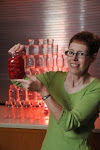The Heritage and Tradition Behind Wisconsin’s Dairy Industry
Did you know…
• Wisconsin’s first cheesemakers were farm wives who, in the 1830s, began making cheese in their kitchens as a way of storing excess milk.
• By 1850, Wisconsin farm wives were producing 400,000 pounds of cheese per year, and selling it for an average of 7 centers per pound. (Today, Wisconsin’s 115 cheese plants produce more than 2.3 billion pounds of cheese annually.)
• John J. Smith buys Wisconsin’s first cheese vat in 1858 and begins producing cheese in Sheboygan County. Smith also is 1st to market Wisconsin cheese outside the state.
• Colby cheese is invented in Colby, Wisconsin, in 1874. Brick cheese is developed in Dodge County several years later. Brick is named for its shape – and because cheesemakers originally used bricks to press whey from the cheese.
• Also in 1890, Stephen Babcock of the University of Wisconsin develops the milkfat test that allows dairymen to determine which cows produce the richest milk – the best for cheesemaking. This test is still used today.
• In 1921, Wisconsin becomes the first state to establish cheese-grading standards to ensure consistent quality and flavor.
• Wisconsin dairy farms produce 22 billion pounds of milk every year. That’s about 13% of the country’s total milk supply.
• Wisconsin is the number 1 cheese-producing state, making more than one of every four pounds produced in the U.S.
• Wisconsin’s cheese plants manufacture more than 2.3 billion pounds of cheese every year – 90% of which is sold outside the state’s borders.
• Wisconsin ranks first among all states in the production of Cheddar, American, Provolone, Brick, Muenster and Limburger cheeses.
• Wisconsin leads the nation in the production of specialty cheeses, such as Asiago, Gorgonzola, Gruyere, Aged Cheddar, Gouda, Blue and many others.
• Wisconsin is home to 115 cheese plants – more than any other state in the country – that produce more than 650 varieties, types and styles of Wisconsin cheese – nearly double that of any other state.





No comments:
Post a Comment